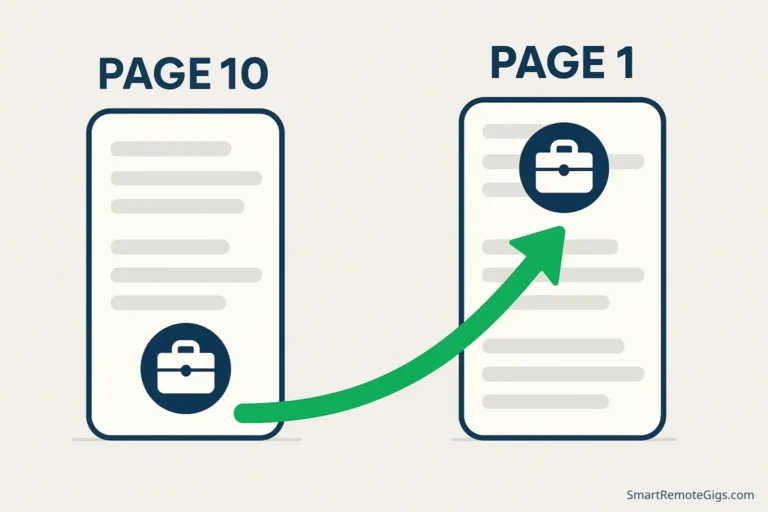“I want to earn more money.” “I want to get better clients.” “I want to be more successful.”
These aren’t goals—they’re wishes. And wishes don’t come with roadmaps. They float around in your head, sounding reasonable but never quite translating into action. You can’t track progress on “more successful.” You can’t tell if you’re halfway there or nowhere close. And without that clarity, you’ll keep spinning your wheels, working hard but never quite knowing if you’re actually moving forward.
Here’s the uncomfortable truth: vague goals produce vague results. The freelancers who build sustainable, profitable businesses aren’t hoping things work out—they’re following a clear plan built on concrete targets. The difference isn’t luck or talent. It’s specificity.
The S.M.A.R.T. framework transforms fuzzy aspirations into actionable freelance business goals you can actually achieve. It’s not complicated or time-consuming. It’s simply a filter that forces you to think clearly about what you’re trying to accomplish and how you’ll know when you get there. By the end of this guide, you’ll know exactly how to set goals that don’t just sound good—they actually drive your business forward.
What Are S.M.A.R.T. Goals? A 1-Minute Refresher
The S.M.A.R.T. framework has been used by businesses and individuals for decades because it works. It’s a simple acronym that ensures your goals have the essential elements needed for success:
Specific: Your goal clearly defines what you want to accomplish, eliminating ambiguity. Instead of “get more clients,” you’d specify “land three new brand design clients in the sustainable fashion industry.”
Measurable: You can track progress and know definitively when you’ve achieved the goal. Numbers, deadlines, and concrete outcomes make this possible.
Achievable: The goal stretches you but remains realistic given your current resources, skills, and circumstances. It’s ambitious without being fantasy.
Relevant: The goal aligns with your broader business objectives and values. It matters to your overall success, not just something that sounds impressive.
Time-bound: You’ve set a clear deadline. Without a timeframe, goals drift indefinitely into “someday.”
Each element serves a purpose. Together, they transform “I hope this happens” into “I’m making this happen by this date, and here’s how I’ll measure it.”
Turning Vague Wishes into S.M.A.R.T. Freelance Goals
Let’s take the most common freelance wish and transform it step-by-step into a goal you can actually achieve. We’ll start with: “I want more clients.”
This statement feels productive, but it’s completely useless as a business goal. More clients than what? By when? What kind of clients? How will you know if you’re making progress? Let’s fix it using each component of the S.M.A.R.T. framework.
Specific: Define Exactly What You Want

Specificity eliminates the guesswork. You’re forcing yourself to articulate precisely what success looks like.
Vague: “I want more clients.”
Specific: “I will land one new client on a monthly retainer.”
Notice what changed. You’ve defined:
- The quantity (one)
- The type of engagement (monthly retainer, not one-off projects)
- The action required (land, which implies outreach and sales activity)
This immediately becomes more actionable. You’re not hoping for “more”—you’re targeting a specific outcome.
Measurable: Add Numbers That Show Progress

If you can’t measure it, you can’t manage it. Measurable components tell you whether you’re on track, behind, or ahead.
Vague: “I want more clients.”
Measurable: “I will land one new client on a monthly retainer of at least $2,000.”
Now you’ve added a concrete financial threshold. This isn’t just any retainer—it’s one that meaningfully contributes to your income targets. You’ll know instantly whether a potential client fits this goal or not.
Many of your most important S.M.A.R.T. goals will be financial. Use How to Make Freelance Financial Projections: Easy Guide to determine the specific numbers that make sense for your business.
Achievable: Ground It in Reality

Achievable doesn’t mean easy—it means possible given your current situation. This is where honest self-assessment matters.
Vague: “I want more clients.”
Achievable: “Based on my current pipeline of five warm leads and my 30% close rate, landing one new client on a $2,000+ monthly retainer is realistic if I focus my outreach efforts.”
Consider:
- How many retainer clients do you currently have?
- What’s your typical conversion rate from lead to client?
- How much time can you realistically dedicate to business development?
- What’s your track record with similar goals?
If you currently have zero retainer clients and have never sold one before, landing three new $2,000 retainers this month probably isn’t achievable. But landing one in the next quarter? That could be a challenging but realistic stretch goal.
Relevant: Connect to Your Bigger Picture

A goal can check all the other boxes but still be a distraction if it doesn’t serve your larger business objectives. Relevant goals move you toward your vision, not away from it.
Vague: “I want more clients.”
Relevant: “This retainer will provide $24,000 in annual recurring revenue, which represents one-third of my annual income target and allows me to serve fewer clients at higher rates.”
Ask yourself:
- Does this goal support my annual income target?
- Does it align with the type of work I want to be doing?
- Will achieving this move me closer to my long-term vision?
- Is this the best use of my time and energy right now?
Suddenly, this isn’t just a random goal—it’s a strategic move toward building the business you actually want.
Time-bound: Set a Clear Deadline

Without a deadline, goals become dreams you’ll get to “someday.” Time-bound goals create urgency and allow you to plan backwards from the deadline.
Vague: “I want more clients.”
Time-bound (Complete S.M.A.R.T. goal): “I will land one new client on a monthly retainer of at least $2,000 by the end of Q2 (June 30), which will provide $24,000 in annual recurring revenue toward my income target.”
This is now a real goal. You can:
- Mark it on your calendar
- Break it into weekly action steps
- Track whether you’re on pace
- Measure success definitively
- Adjust your strategy if you’re falling behind
From “I want more clients” to this specific, measurable, achievable, relevant, and time-bound goal—that’s the power of the S.M.A.R.T. framework.
3 Examples of S.M.A.R.T. Goals for Different Freelancers
To help you see how this framework applies across different freelance disciplines, let’s look at three complete examples. Notice how each goal is crystal clear about what success looks like.
Example 1: The Freelance Writer
Vague goal: “I want to write for better publications.”
S.M.A.R.T. goal: “I will pitch and publish at least one guest article on Medium’s top publications in the marketing category by August 31, generating at least 1,000 views and three inbound client inquiries.”
Why it works:
- Specific: Guest article on Medium’s top marketing publications
- Measurable: One article, 1,000 views, three inquiries
- Achievable: Based on research of similar writers’ success rates
- Relevant: Positions writer as an authority and generates qualified leads
- Time-bound: By August 31
Action steps to get there:
- Research top 10 Medium publications in the marketing niche
- Study their submission guidelines and most popular articles
- Pitch three article ideas per week for 8 weeks
- Write and submit one accepted piece
- Promote the published article through existing network
Example 2: The Web Designer
Vague goal: “I want to learn new skills.”
S.M.A.R.T. goal: “I will complete the Webflow Professional Certification course and build three practice sites in my portfolio by October 15, allowing me to increase my average project rate from $3,500 to $5,000.”
Why it works:
- Specific: Webflow certification plus three portfolio pieces
- Measurable: Course completion, three sites, specific rate increase
- Achievable: Three months is realistic for this level of skill development
- Relevant: Directly enables higher pricing and modern design capabilities
- Time-bound: By October 15
Action steps to get there:
- Enroll in certification course by July 1
- Dedicate 5 hours per week to coursework
- Complete one practice site per month (July, August, September)
- Update portfolio and service offerings by October 1
- Announce new capabilities to existing network
Example 3: The Virtual Assistant
Vague goal: “I want my business to run more smoothly.”
S.M.A.R.T. goal: “I will create and implement a standardized client onboarding system by September 30, reducing my onboarding time from 4 hours to 90 minutes per new client, allowing me to take on two additional clients this quarter.”
Why it works:
- Specific: Standardized onboarding system
- Measurable: Time reduction from 4 hours to 90 minutes, capacity for 2 more clients
- Achievable: Systems work takes focused time but is entirely within control
- Relevant: Efficiency gains create capacity for growth without burnout
- Time-bound: By September 30
Action steps to get there:
- Document current onboarding process and identify bottlenecks
- Create template emails, contracts, and questionnaires
- Set up automated workflow in project management system
- Test system with one new client and refine
- Roll out to all new clients starting October 1
Notice how each of these examples transforms a vague desire into something you could literally put on your project management board and execute.
Common Pitfalls When Setting Freelance Goals (And How to Avoid Them)
Even with the S.M.A.R.T. framework, freelancers often make predictable mistakes. Here’s how to sidestep them:
Problem #1: Setting too many goals at once
You have 10 things you want to improve. So you set 10 goals. Within two weeks, you’re overwhelmed and making progress on none of them.
Solution: Choose 1-3 primary goals per quarter. That’s it. You can have aspirational goals for the year, but your active focus should be narrow. Once you achieve a goal, you can add another.
Problem #2: Making goals too dependent on others
“I will land five new clients this month” sounds S.M.A.R.T., but you can’t control whether people say yes. You can only control your actions.
Solution: Focus on input goals you can control: “I will have discovery calls with 15 qualified prospects this month.” If your close rate is typically 30%, you’ll likely land 4-5 clients—but the goal is about the activity you control.
Problem #3: Forgetting to review and adjust
You set goals in January with good intentions. By March, you’ve completely forgotten what they were.
Solution: Schedule a monthly “goal review” appointment with yourself. Thirty minutes to assess progress, celebrate wins, and adjust course if needed.
Problem #4: Setting goals that sound impressive but don’t matter
“I will post on LinkedIn every day for 90 days” might sound like a solid goal, but if your ideal clients aren’t on LinkedIn, you’re just creating busywork.
Solution: Always connect goals back to outcomes. “I will post on LinkedIn three times per week, generating at least 10 meaningful conversations with potential clients per month.”
How to Actually Achieve Your S.M.A.R.T. Goals
S.M.A.R.T. goals are worthless if they live only in a document you never look at. The framework gets you to clarity—but execution requires a system. Here’s how to turn your goals into reality.
Break Goals Into Weekly Action Steps
Your quarterly goal needs to become this week’s to-do list. For each goal, ask: “What are the 3-5 major milestones required to achieve this?” Then ask: “What do I need to do this week to move toward the next milestone?”
Example: Your goal is to land one $2,000 retainer client by June 30.
Major milestones:
- Identify and research 20 ideal prospects
- Reach out to all 20 prospects
- Have discovery calls with 6-8 interested prospects
- Send proposals to 3-4 qualified leads
- Close one client
This week’s actions:
- Research 5 ideal prospects and gather contact information
- Draft outreach email template
- Send 5 personalized outreach emails
Suddenly, “land a retainer client” becomes “send 5 emails this week.” That’s doable.
Review Progress Monthly
Block 30 minutes at the start of each month to review your goals. Use these three questions:
- Am I on track? If your goal requires landing one client by June 30 and it’s now May 1, have you completed the research and outreach phases?
- What’s working? If you’ve already had three discovery calls from just 10 outreach emails, your messaging is clearly resonating. Double down on what’s working.
- What needs to adjust? If you’ve sent 20 emails with zero responses, your targeting or messaging needs work. Don’t wait until the deadline to course-correct.
This monthly check-in prevents you from sleepwalking through a quarter and realizing in week 12 that you’re nowhere near your target.
Celebrate Wins (Even Small Ones)
Freelancing can feel like a lonely grind. When you hit a milestone—even an intermediate one—acknowledge it. Finished your outreach list? That’s progress. Had your first discovery call? That’s movement. Closed the deal? That’s victory.
Celebrating progress reinforces the behavior and keeps you motivated through the longer journey.
Connect Goals Back to Your Business Plan
Your goals shouldn’t exist in isolation. They should ladder up to your larger business strategy. This is why your freelance business plan matters—it’s the framework that ensures all your goals work together toward a coherent vision.
If your business plan says your niche is sustainable fashion brands, but your goals involve landing clients in tech startups, something’s misaligned. Your monthly review is a chance to check this alignment.
For the complete picture of how goals, projections, and strategy work together, revisit How to Write a Freelance Business Plan (A Simple 1-Page Guide).
Your Next Step: Set Your First S.M.A.R.T. Goal Today
Reading about goal-setting is easy. Actually setting a goal and committing to it? That takes courage. But it’s also the only thing that will change your business.
You don’t need to map out your entire year right now. Start with one goal. One clear, specific, measurable, achievable, relevant, and time-bound target for the next 90 days.
Ask yourself:
“What’s the single most important thing I could accomplish in the next three months that would meaningfully improve my freelance business?”
That’s your first S.M.A.R.T. goal. Write it down. Put it somewhere visible. Break it into weekly steps. And start working on it today.
The freelancers who succeed aren’t the ones with the most talent or the best luck. They’re the ones who know exactly where they’re going and take consistent action to get there. Your S.M.A.R.T. goals are your roadmap.
What will you accomplish in the next 90 days?
A step-by-step guide on using the S.M.A.R.T. framework to transform vague freelance wishes into specific, actionable, and measurable business goals that drive real progress.
Total Time: 30 minutes
Make Your Goal Specific
Take a vague wish, like “get more clients,” and define exactly what you want to accomplish. Specify the quantity, the type of engagement, and the desired outcome. For example, change it to “land one new client on a monthly retainer.”
Make Your Goal Measurable
Add concrete numbers to your goal so you can track progress. Incorporate a financial threshold or a clear metric of success. For example, “land one new client on a monthly retainer of at least $2,000.”
Ensure Your Goal is Achievable
Assess your current situation, including your pipeline, skills, and available time, to ensure the goal is realistic. It should be a stretch that motivates you, not a fantasy that discourages you.
Confirm Your Goal is Relevant
Connect the goal to your larger business objectives. Ask yourself if achieving it will support your annual income target and move you closer to your long-term vision. This ensures you’re working on what truly matters.
Set a Time-Bound Deadline
Assign a clear deadline to your goal, such as “by the end of Q2.” A timeframe creates urgency and allows you to break the goal down into smaller weekly or monthly action steps, transforming it from a “someday” wish into a real project.
Tools:
- Notebook or document for writing down goals
- Your freelance business plan or financial projections for reference
- Calendar or project management tool






